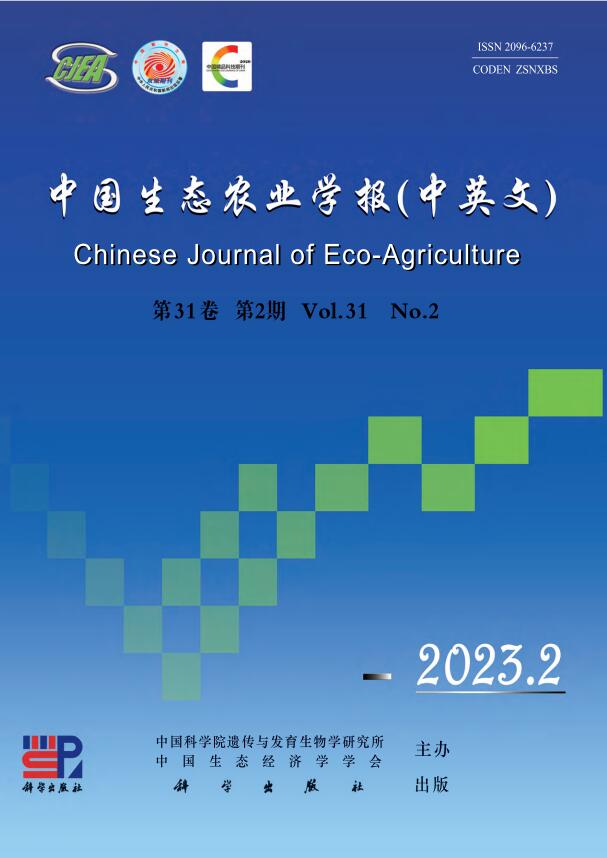2022, 30(6): 990-1001.
doi: 10.12357/cjea.20210665
Abstract:
Reasonable intercropping patterns of crops have positive regulatory effects on the metabolic functional diversity of soil microbial communities. To explore the functional diversity of the soil microbial community and the characteristics of soil microbial transformation in soil nutrients and carbon source utilization in intercropping of banana and sweet potato, the changes in soil microbial functional diversity under banana monoculture and banana-sweet potato intercropping in ‘Guijiao No. 1’ banana plantation were compared and analyzed by using the Biolog method and principal component analysis. The results showed that the soil microbial metabolic activity from the vegetative growth stage to the budding stage of banana could be significantly improved by intercropping sweet potato in a banana plantation (P<0.01). The average color change rate of the intercropping soil microbial community was increased by 0.77–14.36 times, and the diversity, dominance, and richness of the soil microbial community increased by 0.09–1.01, 0.02–0.31, and 0.52–5.04 times, respectively, compared with those of the single cropping. However, there was no significant difference in soil microbial community evenness between intercropping and monoculture in the banana orchards. In addition, the carbon source utilization and metabolic activity of soil microorganisms increased in banana plantations intercropped with sweet potato. The metabolic activities of soil microorganisms for carbohydrates, amino acids, carboxylic acids, polymers, phenolic acids, and amines in intercropping were 13.81, 9.22, 5.38, 9.93, 6.08, and 3.46 times higher than those in the monoculture, respectively. There were differences in the utilization efficiency of different carbon sources between monoculture and intercropping systems. Carbohydrates and amino acids were the main metabolic carbon sources for soil microorganisms in intercropping, and polymer compounds and phenolic acids were the main metabolic carbon sources in the monoculture. The number of carbon sources utilized by soil microbial communities in intercropping was increased by 9–28 times compared with that of the monoculture, and the difference between intercropping and monoculture reached a very significant or significant level (P<0.01 or P<0.05, respectively). For banana intercropping with sweet potato, the utilization rate of carbohydrates by soil microorganisms was the highest, reaching 20.29%–25.25%, followed by amino acids with a utilization rate of 18.58%–20.31%, whereas the utilization rate of carboxylic acids, multi-cluster compounds, phenolic acids, and amines was lower than 18.28%. For banana monoculture, the utilization rate of multi-cluster compounds by soil microorganisms was the highest, reaching 0.60%–52.71%, followed by phenolic acids with the utilization rate of 13.94%–26.56%, whereas the utilization rate of the other four carbon sources was lower than 17.82%. There were notable differences in the utilization efficiency of single carbon sources by soil microorganisms between banana intercropping with sweet potato and banana monoculture. The main carbon sources used by intercropping soil microorganisms were d-cellobiose, N-acetyl-d-glucosamine, d-mannitol, α-d-lactose, d-galacturonic acid, d-xylose, l-arginine, and l-asparagine, accounting for 24.53%–31.12% of the total carbon sources. The carbon sources utilized by monoculture microorganisms included Tween-80, L-arginine, N-acetyl-d-glucosamine, L-asparagine, γ-hydroxybutyric acid, and α-d-lactose, accounting for 32.02%–78.45% of the total carbon source. Principal component analysis showed that carbohydrates and amino acids were the main carbon sources that changed the soil microbial diversity of banana intercropping with sweet potato. The diversity of rhizosphere soil microbial communities in banana plantations could be improved, and the carbon sources utilization efficiency and activity of the soil microbial community were improved by intercropping sweet potato; thus, the functional diversity of the rhizosphere microbial community was significantly improved.
LI Y P, LIN J Q, XIAO S X, FENG D, DENG Y Y, XUAN W Y. Effects of intercropping sweet potato in banana plantation on functional diversity of soil microorganisms[J]. Chinese Journal of Eco-Agriculture, 2022, 30(6): 990−1001. doi: 10.12357/cjea.20210665.










